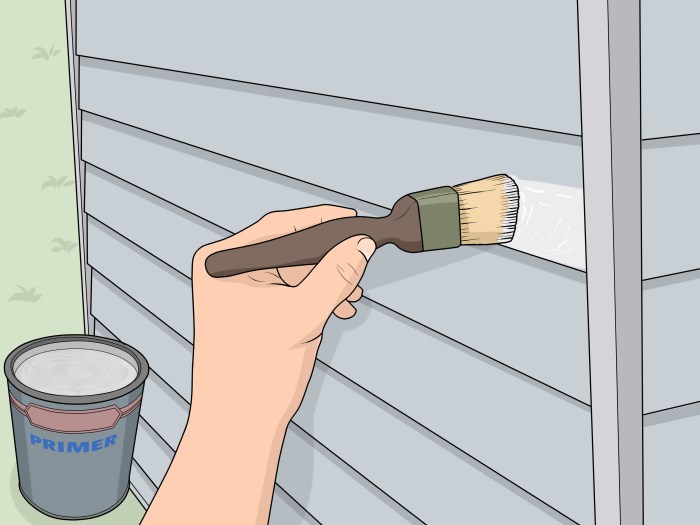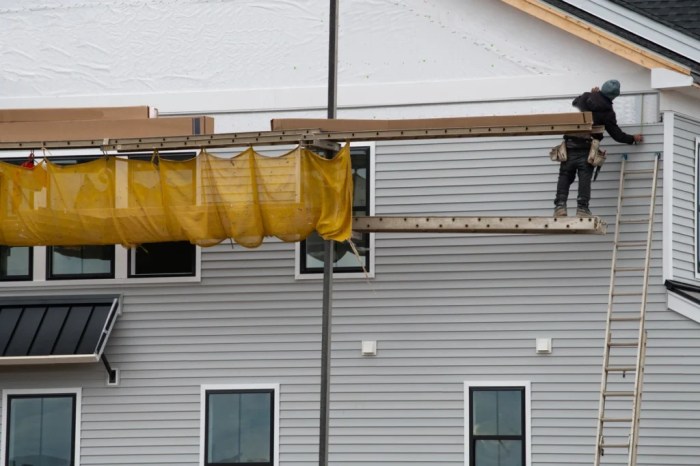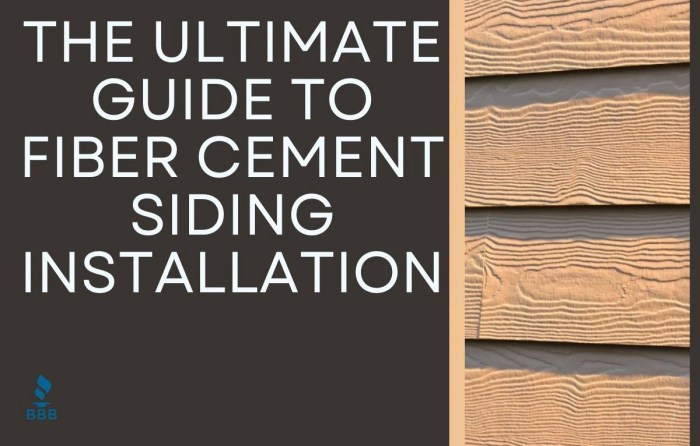The Ultimate Guide to Fiber Cement Siding Installation
As we delve into the world of fiber cement siding installation, prepare to be amazed by the versatility and durability of this material. From its unique composition to the seamless installation process, this guide will equip you with the knowledge needed to transform your home with ease.
Exploring the benefits, installation steps, and safety considerations, this comprehensive guide covers all aspects of fiber cement siding installation to ensure a successful project from start to finish.
Introduction to Fiber Cement Siding Installation
Fiber cement siding is a durable and versatile building material made from a combination of cement, sand, and cellulose fibers. It is known for its resistance to fire, insects, rot, and harsh weather conditions, making it a popular choice for homeowners and builders alike.
Benefits of Fiber Cement Siding
- Excellent Durability: Fiber cement siding can last for decades with minimal maintenance, saving homeowners money in the long run.
- Weather Resistance: With its ability to withstand extreme temperatures, moisture, and UV exposure, fiber cement siding is ideal for all climates.
- Fire Resistance: Unlike wood siding, fiber cement is non-combustible, providing an added layer of protection for homes.
- Low Maintenance: Fiber cement siding requires minimal upkeep, with periodic cleaning being the main task to keep it looking fresh.
Installation Process Overview
Installing fiber cement siding involves several steps, including:
- Preparation: This includes removing old siding, inspecting the structure for damage, and ensuring a clean and level surface.
- Trim Installation: Trim pieces are installed around windows, doors, and corners to provide a finished look and seal off edges.
- Panel Installation: Fiber cement panels are then cut to size and attached to the exterior walls using nails or screws.
- Finishing Touches: Once the panels are in place, any gaps are filled with caulk, and the siding is painted or primed for a polished appearance.
Pre-Installation Preparation

Fiber cement siding installation requires careful planning and preparation to ensure a successful outcome. This includes gathering the necessary tools and materials, preparing the surface properly, and accurately calculating the amount of siding needed for the project.
Tools and Materials Required
Before starting the installation process, make sure you have the following tools and materials on hand:
- Fiber cement siding panels
- Tape measure
- Pencil
- Straight edge
- Circular saw or snips
- Nails or screws
- Hammer or screwdriver
- Level
- Safety goggles and gloves
- Caulk and caulk gun
- Paint and primer (if needed)
Importance of Proper Surface Preparation
Proper surface preparation is crucial for the longevity and durability of your fiber cement siding. Before installation, ensure that the surface is clean, dry, and free of any debris or obstacles. This will help prevent moisture issues, improve adhesion, and ensure a smooth and seamless finish.
Additionally, inspect the surface for any signs of damage or rot. Replace or repair any compromised areas before proceeding with the installation to avoid future problems.
Measuring and Calculating Siding Amount
Accurately measuring and calculating the amount of siding needed for your project is essential to avoid running out of materials or overspending. Follow these steps to determine the quantity of siding required:
- Measure the height and width of each wall where siding will be installed.
- Calculate the square footage of each wall by multiplying the height by the width.
- Add up the square footage of all walls to determine the total area to be covered.
- Consider adding extra material for waste, cuts, and future repairs.
- Consult with a professional or use an online siding calculator to determine the exact amount of siding needed.
Installation Steps

Installing fiber cement siding involves a step-by-step process that ensures proper attachment and a secure finish. One crucial aspect of the installation is cutting and trimming the siding panels accurately to fit the specific dimensions of the structure. Additionally, proper attachment and fastening techniques are essential to ensure the siding remains secure and stable over time.
Cutting and Trimming Fiber Cement Siding
When cutting fiber cement siding panels, it is important to use the right tools and techniques to achieve clean and accurate cuts. Here are some best practices to follow:
- Use a carbide-tipped scoring knife or shears designed for cutting fiber cement to score the panel.
- After scoring the panel, carefully snap it along the scored line to create a clean break.
- For more precise cuts, use a circular saw with a diamond-tipped blade or a specialized fiber cement blade.
- Always wear appropriate safety gear, such as goggles and a dust mask, when cutting fiber cement siding.
Attaching and Fastening the Siding Securely
Properly attaching and fastening fiber cement siding is crucial to ensure its longevity and stability. Here are some best practices for attaching and fastening the siding securely:
- Begin by installing a moisture barrier, such as house wrap, to protect the structure from water damage.
- Use corrosion-resistant nails or screws specifically designed for fiber cement siding to secure the panels to the structure.
- Leave a small gap between the siding panels to allow for expansion and contraction due to changes in temperature.
- Ensure the panels are properly aligned and leveled during installation to maintain a uniform appearance.
- Follow the manufacturer’s guidelines for spacing and fastening requirements to ensure the siding is installed correctly.
Safety Considerations

When it comes to fiber cement siding installation, safety should always be a top priority. There are several potential hazards that can arise during the installation process, so it is important to take necessary precautions to protect yourself and others.
Identifying Safety Hazards
- Working at heights: Installing siding often involves working on ladders or scaffolding, which can lead to falls if not done properly.
- Dust and debris: Cutting and handling fiber cement materials can create dust particles that can be harmful if inhaled.
- Sharp edges: Fiber cement siding can have sharp edges that can cause cuts or injuries if not handled carefully.
Safety Tips for Working with Fiber Cement Materials
- Wear appropriate clothing: Long sleeves, gloves, and safety glasses can help protect you from cuts, scrapes, and dust.
- Use proper tools: Make sure you are using the correct tools for cutting and installing fiber cement siding to avoid accidents.
- Work in a well-ventilated area: Proper ventilation can help reduce the amount of dust in the air and minimize the risk of inhaling harmful particles.
Using Personal Protective Equipment (PPE)
- Respiratory protection: When cutting fiber cement siding, it is important to wear a mask to prevent inhaling dust particles.
- Eye protection: Safety glasses or goggles should be worn to protect your eyes from dust and debris.
- Gloves: Wear gloves to protect your hands from sharp edges and cuts while handling the siding.
Summary
In conclusion, fiber cement siding installation offers a perfect blend of functionality and aesthetic appeal for your home. By following the Artikeld steps and safety precautions, you can achieve a seamless installation that enhances both the value and curb appeal of your property.
Dive into the world of fiber cement siding installation today and elevate your home’s exterior with confidence.
FAQ Guide
What are the advantages of fiber cement siding?
Fiber cement siding offers exceptional durability, resistance to fire and pests, low maintenance requirements, and a wide range of design options.
How do you calculate the amount of siding needed for a project?
To calculate the amount of siding needed, measure the height and width of each wall, subtracting areas for doors and windows, and then multiply the total square footage by the number of siding panels per square foot.
What safety hazards should I be aware of during fiber cement siding installation?
Potential safety hazards include inhaling silica dust when cutting the siding, handling sharp edges, and working at heights. It’s crucial to wear appropriate safety gear and follow proper safety protocols.




